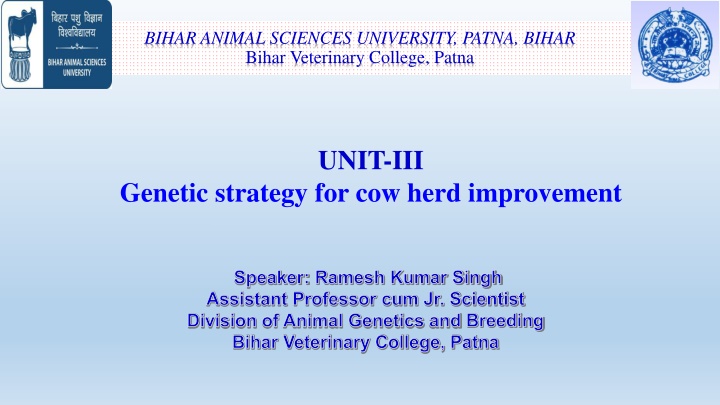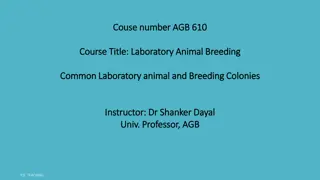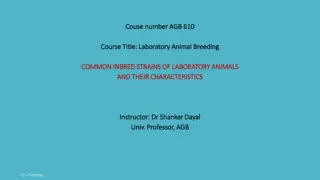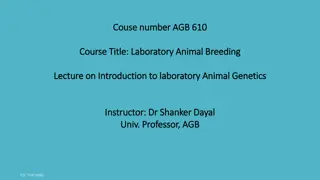
Genetic Strategy for Cow Herd Improvement & Crossbreeding Benefits
Enhance your cow herd with a logical genetic strategy including determining production conditions, choosing breeding systems, and selecting useful individuals. Explore the benefits of crossbreeding like heterosis, favorable breed combinations, and complementarity for improved performance and offspring vitality.
Download Presentation

Please find below an Image/Link to download the presentation.
The content on the website is provided AS IS for your information and personal use only. It may not be sold, licensed, or shared on other websites without obtaining consent from the author. If you encounter any issues during the download, it is possible that the publisher has removed the file from their server.
You are allowed to download the files provided on this website for personal or commercial use, subject to the condition that they are used lawfully. All files are the property of their respective owners.
The content on the website is provided AS IS for your information and personal use only. It may not be sold, licensed, or shared on other websites without obtaining consent from the author.
E N D
Presentation Transcript
BIHAR ANIMAL SCIENCES UNIVERSITY, PATNA, BIHAR Bihar Veterinary College, Patna UNIT-III Genetic strategy for cow herd improvement Speaker: Ramesh Kumar Singh Assistant Professor cum Jr. Scientist Division of Animal Genetics and Breeding Bihar Veterinary College, Patna
Genetic strategy for cow herd improvement A logical genetic strategy for cow herd improvement should include four steps. 1 determine your production conditions (including climatic, for-age and marketing) and the levels of animal performance that fit those conditions. 2 choose a breeding system. 3 identify the biological types and breeds within those types that are compatible with the first two considerations. 4 select for breeding the most useful individuals within those breeds.
Approaches of Matings Commercial cow/calf producers who confine themselves to one breed have straight bred herds. If more than one breed is used, the herd is crossbred. Straight breeding : It simply means using the same breed for both sires and dams. Inbreeding occurs over time in any breed, particularly in breeds closed to outside breeding stock. This can reduce performance (called inbreeding depression), especially in traits such as fertility, liveability and longevity. One type of inbreeding called linebreeding if carefully planned elevate the influence of a genetic line or individual while minimizing inbreeding over all.
Crossbreeding Crossbreeding begins with the mating of two purebreds of different breeds. There are three potential benefits of crossbreeding Heterosis Favorable breed combinations Complementarity
Heterosis Heterosis, also called hybrid vigor, occurs when the performance of crossbred progeny is different than the average of their parent types. Heterosis is greatest in the progeny of least related parents. Heterosis is reduced when both parents contain the same breed. There is no loss of heterosis if the parents share no breed in common, whether the parents are purebreds or crossbreds. If an F1 is bred to either of its parent breeds (called a backcross), heterosis in its progeny is about half of that expressed in the F1. If the F1 is not backcrossed but is bred to a third breed, or an unrelated crossbred, there should be no loss of heterosis in its progeny because the sire and dam have no breed in common as in a backcross.
Contd If two F1s of the same cross are mated, the progeny called F2 should have about half the heterosis of the F1. If F2s and subsequent generations of this cross are intermated, their progeny average no additional loss of heterosis except for any inbreeding that might develop over time. Characteristics express heterosis differently. Heterosis tends to be highest in fertility, livability, and longevity; intermediate in milk production, weight gain, feed efficiency and body size; and lowest in carcass traits. The most productive crossbreds come from genetically superior parents.
Favorable Breed Combinations Even without heterosis there can be benefits merely from combining breeds. For example, breeds with high carcass quality are generally not well adapted to tropical conditions, and those that do have good tropical adaptability usually have relatively low carcass quality. Crossing breeds of these two types can produce progeny with an acceptable intermediate level of both traits. Such favorable breed combinations can be the most important benefit of crossbreeding.
Complementarity Complementarity requires dissimilar sires and dams. Complementarity results not only from the favourable combination of different types but also from the manner in which they are combined.
Thanking you Thanking you
















